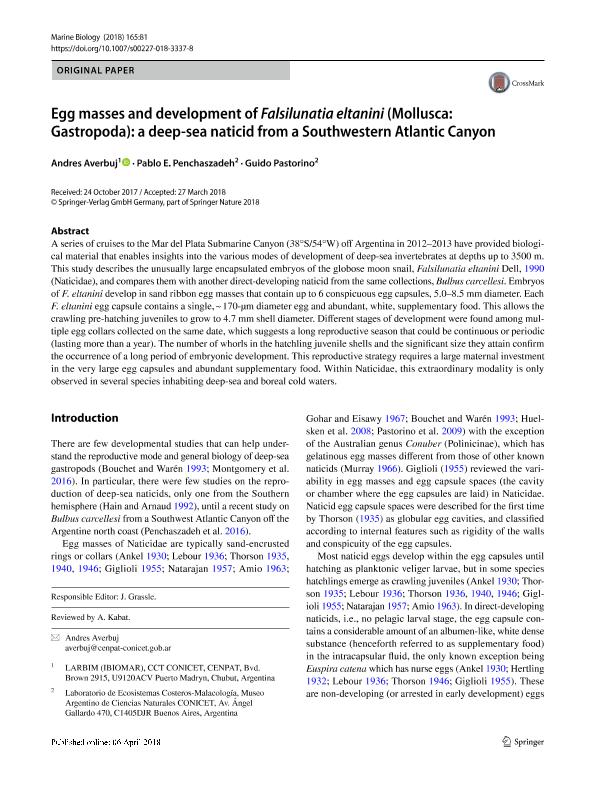Mostrar el registro sencillo del ítem
dc.contributor.author
Averbuj, Andres

dc.contributor.author
Penchaszadeh, Pablo Enrique

dc.contributor.author
Pastorino, Roberto Santiago Guido

dc.date.available
2019-11-25T22:05:28Z
dc.date.issued
2018-05
dc.identifier.citation
Averbuj, Andres; Penchaszadeh, Pablo Enrique; Pastorino, Roberto Santiago Guido; Egg masses and development of Falsilunatia eltanini (Mollusca: Gastropoda): a deep-sea naticid from a Southwestern Atlantic Canyon; Springer; Marine Biology; 165; 5; 5-2018; 1-10
dc.identifier.issn
0025-3162
dc.identifier.uri
http://hdl.handle.net/11336/90389
dc.description.abstract
A series of cruises to the Mar del Plata Submarine Canyon (38°S/54°W) off Argentina in 2012–2013 have provided biological material that enables insights into the various modes of development of deep-sea invertebrates at depths up to 3500 m. This study describes the unusually large encapsulated embryos of the globose moon snail, Falsilunatia eltanini Dell, 1990 (Naticidae), and compares them with another direct-developing naticid from the same collections, Bulbus carcellesi. Embryos of F. eltanini develop in sand ribbon egg masses that contain up to 6 conspicuous egg capsules, 5.0–8.5 mm diameter. Each F. eltanini egg capsule contains a single, ~ 170-µm diameter egg and abundant, white, supplementary food. This allows the crawling pre-hatching juveniles to grow to 4.7 mm shell diameter. Different stages of development were found among multiple egg collars collected on the same date, which suggests a long reproductive season that could be continuous or periodic (lasting more than a year). The number of whorls in the hatchling juvenile shells and the significant size they attain confirm the occurrence of a long period of embryonic development. This reproductive strategy requires a large maternal investment in the very large egg capsules and abundant supplementary food. Within Naticidae, this extraordinary modality is only observed in several species inhabiting deep-sea and boreal cold waters.
dc.format
application/pdf
dc.language.iso
eng
dc.publisher
Springer

dc.rights
info:eu-repo/semantics/openAccess
dc.rights.uri
https://creativecommons.org/licenses/by-nc-sa/2.5/ar/
dc.subject
COLD WATER ENVIRONMENTS
dc.subject
DIRECT DEVELOPMENT
dc.subject
LARVAL ECOLOGY
dc.subject
GASTROPOD EGG MASSES
dc.subject.classification
Biología Marina, Limnología

dc.subject.classification
Ciencias Biológicas

dc.subject.classification
CIENCIAS NATURALES Y EXACTAS

dc.title
Egg masses and development of Falsilunatia eltanini (Mollusca: Gastropoda): a deep-sea naticid from a Southwestern Atlantic Canyon
dc.type
info:eu-repo/semantics/article
dc.type
info:ar-repo/semantics/artículo
dc.type
info:eu-repo/semantics/publishedVersion
dc.date.updated
2019-10-22T15:55:15Z
dc.identifier.eissn
1432-1793
dc.journal.volume
165
dc.journal.number
5
dc.journal.pagination
1-10
dc.journal.pais
Alemania

dc.description.fil
Fil: Averbuj, Andres. Consejo Nacional de Investigaciones Científicas y Técnicas. Centro Científico Tecnológico Conicet - Centro Nacional Patagónico. Instituto de Biología de Organismos Marinos; Argentina
dc.description.fil
Fil: Penchaszadeh, Pablo Enrique. Consejo Nacional de Investigaciones Científicas y Técnicas. Oficina de Coordinación Administrativa Parque Centenario. Museo Argentino de Ciencias Naturales “Bernardino Rivadavia”; Argentina
dc.description.fil
Fil: Pastorino, Roberto Santiago Guido. Consejo Nacional de Investigaciones Científicas y Técnicas. Oficina de Coordinación Administrativa Parque Centenario. Museo Argentino de Ciencias Naturales “Bernardino Rivadavia”; Argentina
dc.journal.title
Marine Biology

dc.relation.alternativeid
info:eu-repo/semantics/altIdentifier/doi/http://dx.doi.org/10.1007/s00227-018-3337-8
dc.relation.alternativeid
info:eu-repo/semantics/altIdentifier/url/https://link.springer.com/article/10.1007%2Fs00227-018-3337-8
Archivos asociados
